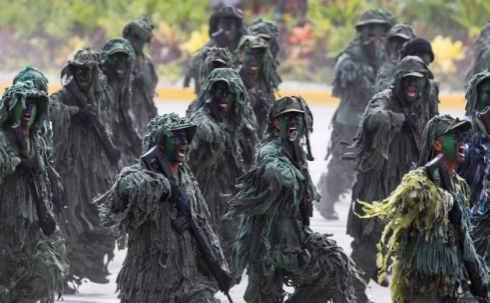In the 1960s (1963-1967), the Venezuelan government established thirteen "Hunter Battalions" dedicated to fighting rebel left-wing forces, drug dealers, etc. – their teachers were the U.S. Army's 7th Special Forces (Airborne Force) and the defunct 8th Special Forces — which in South America were known as "masters of national coups" (the CIA often used them to replace South American governments);

In 1981, the Venezuelan Army's "General Andrés Haas/Division" Special Operations School was established: in addition to training Army Special Forces, it has always been the activity and training base of the US Special Forces in South America - many South American and African pro-American Special Forces are "training" here: training according to the content of the US Special Forces training. These include basic survival training, operations after being captured by the enemy, how to break through obstacles, combat sabotage and confrontation, counterterrorism training, sniper training, boarding training, guerrilla warfare and counter-guerrilla warfare, chemical warfare, marching and camping, psychological warfare, subversive government skills, physical training, patrol and vigilance, amphibious operations, blasting and destruction, light equipment diving and high-altitude parachute training, etc. – training is the responsibility of the U.S. Military Special Forces and the U.S. CIA;
The Venezuelan Army Special Forces School is located in the Caribbean coastal city of Montes in the State of Sucre, more than 540 kilometers from caracas, the capital of Venezuela;
In addition, the 8th Special Operations Brigade and the 42nd Airborne Brigade of the Venezuelan Marine Corps are elite special forces; among them, the 42nd Airborne Brigade is the key unit supported by Chávez: participate in the military operation to rescue Chávez!
In a military coup d'état in April 2002, President Chávez was detained on the island of Ochira by pro-American opposition. Lieutenant Colonel Villenzaura of the 42nd Venezuelan Paratrooper Brigade organized the rescue: First, he and the professionals of the armed forces rescued President Chávez through officers who infiltrated the coup;
Lieutenant Colonel Villeneuse and others formed 3 teams: a total of 12 members, one group of professionals from the military office of the Presidential Office, one group of medical personnel, and the other group already on the island of Ochira, which made the rescue mission easier. The professionals received orders to rescue President Chávez, flew by helicopter to the Caribbean island of Ochira, and then dispersed; at 12 o'clock in the evening of the 13th, they left the island with President Chávez and flew by helicopter to the Presidential Palace, where Chávez successfully regained power with the assistance of the old troops.
The 42nd Airborne Brigade has a long history: after World War II, the Airborne Paratrooper Corps (Company-level Units) was established. At first, only a few paratrooper officers had received paratrooper training abroad, the rest of the facilities and personnel were extremely scarce, and it did not train according to the paratrooper specifications, but only fought as a light infantry on the border and at home against the anti-government left-wing guerrillas; in 1966, it was trained by the 82nd Airborne Division at Fort Bragg of the US Army and held joint exercises; in February 1977, it was officially upgraded to a regimental unit; in February 1989, it was upgraded from a brigade unit; in 1992, Lieutenant Colonel Chávez, commander of the Paratrooper Brigade's Air Landing Battalion, led a "two-four" military coup d'état to overthrow President Andrés Pérez, which failed and Chavez was arrested and imprisoned; in 1994, Chávez was pardoned by President Rafael Caldera. After the failed coup, the 42nd Airborne Brigade was demoted to a company unit, and only one Barracks in Malakai remained, Chavez, who was sentenced to prison;
In December 1998, Chávez ran for office as the presidential candidate of the Left-Wing Campaign Alliance "Patriotic Center" and was elected president, taking office in February 1999. The first thing he did after he became president about the reform of the army: the restoration of the 42nd airborne felt honorable and organized! Military spending, weapons, facilities and personnel are focused on the brigade – it was the most elite unit in the Venezuelan armed forces before the 2002 coup d'état.
At present, the 42nd Airborne Brigade is led by 7 lieutenant colonels, 20 majors, 18 captains and 68 lieutenants, 48 middle and senior sergeant majors and 145 corporals to form a combat backbone, and more than 2250 volunteers. The brigade was organized into 3 assault battalions, each consisting of 4 assault companies, 1 curved fire company, and 1 support and logistics platoon. Light weapons are mainly composed of Russian-made automatic rifles, Chinese submachine guns/sniper rifles, etc., and the old FN CAL/FNC gun family, American-made M-16A2, etc. have been eliminated to the "Bolivarian militia" organization; the main detachment firepower includes Swedish 84mm recoilless guns, Russian-made rocket launchers, and medium-made grenade launchers;
Every soldier of the 42nd Airborne Brigade must serve in the army for more than two years and have good combat skills to apply for membership; after joining, they must go through 6 months of advanced infantry tactical training, and then select outstanding people to participate in a one-month parachute training, and after completing 5 air jumps, they are officially qualified to join the brigade. Its promotion system is also very strict: soldiers promoted to non-commissioned officers in the brigade must serve in the brigade for more than 12 months to receive promotion examinations and examinations; officers must also reach more than 60 months;
Thus, the overall quality of the 42nd Airborne Brigade, trained according to a training mechanism similar to that of Israeli paratroopers, is an elite force in South America: it actively participates in defending the Maduro regime, fighting drug trafficking, countering joint Colombian/U.S. special forces sneak attacks, eliminating mercenaries from the U.S. "retired SEALs" who invaded at sea, freeing hostages, participating in Peacekeeping in Honduras... It has become an indispensable multi-purpose military unit of the Venezuelan army – marked by the red beret – which is tantamount to a red devil in the eyes of the enemy!